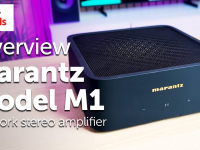
In the pantheon of Hi-Fi nobility, few companies have as rich a history as the oft-celebrated Marantz.
Originating in 1950’s New York, helmed by one Saul B. Marantz, the company is predominantly now synonymous with Japanese hi-fi, after the burgeoning manufacturer was split into separate entities in the mid 1970s. With part of the manufacturing arm once owned by Philips Electronics and rights to the name owned by the then-newly-formed Marantz Japan Inc., the brand has had a wide influence over the industry for almost as long as any.
On a smaller scale, Marantz for many people will be a reminder of a first hi-fi system – maybe a CD player or amplifier (and probably one that lasted as long as it was asked to, and beyond). That’s not to say that they only offer entry level gear – far from it. A lot of ‘end game’ systems have been touched by the mighty hand of Ken Ishiwata, and the bronzed nomenclature KI sits proudly upon many thousands of pounds worth of equipment.
Today, we’re going to take a look at one of Marantz’ key lines – and as luck would have it, it’s most cost-friendly to boot.
The ‘5’ series of products has long been a staple of Marantz’ hi-fi range. This year’s update sees the brand spanking new PM5005 amplifier introduced, alongside the CD5005 CD player. Not that you’d know it to look at them. Marantz have long favoured a case design that is often then used for years at a time, with almost no physical changes at all. This makes a great deal of sense for all parties. Money not spent on re-designs is passed on to the consumer, and the layout becomes second nature for the user if they do happen to upgrade over time. So no big changes round the front, but a few new additions under the bonnet.
The PM5005 is the first of Marantz’ budget line to make use of its Current Feedback architecture; something they’ve previously reserved for their high end gear. The technology is designed to provide as fast and as accurate signal processing as possible, which is claimed to bring hugely improved stereo separation as well as improving sound staging. The amplifier is a solid 40w into 8 ohms (which is more than palatable at the price point) and its wealth of connections are much welcomed too. A moving-magnet phono-stage is provided for turntable use and two pairs of speaker terminals provided, to allow for a second set to run in another room. A good quality headphone output rounds off the suite.
The CD5005 is a new play on the previous CD5004, but with a now-mandatory DAC chip update. The chip in question is the CS4398 from Cirrus Logic, and coupled with a new CD mechanism, was definitely a worthwhile change. Whilst it does unfortunately miss out on the front mounted USB input that is pricier sibling the CD6005 has, the drive itself is still able to play back MP3 / WMA files from CD.
Given their previous synergy, we decided to try the 5005’s with Monitor Audio’s BX2 & BX5 speakers for our run-out. The choice proved a fruitful one. Coldplay’s latest work ‘Ghost Stories’ may not have had ’em listening in their droves, but its mostly downbeat, dance-tinged songs offer a good test to many a system (Chris Martin’s leaden lyrics aside). ‘Midnight’, the Jon Hopkins produced-and-sampling single is a great test of bass, particularly the intro to the second verse. The Marantz combo handled this with aplomb, with the full bloom of the lower range showing itself even through the bookshelf BX2. With the BX5 we nearly lost a window! Classical fared well too, with the Lazar Berman rendition of Liszt’s ‘La Mal du Pays’ offering delicacy, poise and importantly, not too much leading edge on highs.
Of course, the 5005 isn’t infallible. It sounded flatter dynamically than, say, the Arcam A19 & CD17, offering less depth and height to its soundstage – but for its price point it certainly didn’t show itself up.
For a lot of people this might be all they’ll ever need, for others it will be their first step onto the audiophile ladder, like many more before them.
Shop Marantz with Richer Sounds.
Author – Chris, Liverpool store





